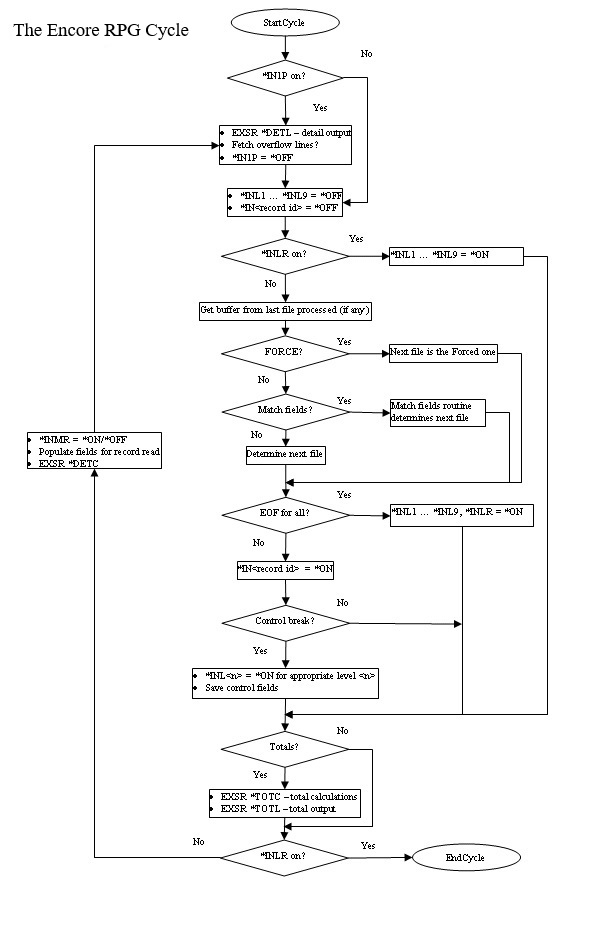RPG Cycle
Estimated reading time: 4 minutes
Encore RPG feature RPG Cycle support for Monarch migrated applications. Since most ECR programmers already “know” the RPG Cycle, only an overview of how the cycle works and is supported with Encore RPG is included. For more information, please see the Cycle Support topic in the Monarch Migration manual or the Cocoon help file.
The RPG compiler supplies part of the logic for an RPG program. That logic is called the program cycle or RPG cycle . The program cycle is a series of ordered steps that the main procedure goes through for each record read.
The information specifies when records should be read or written. The RPG compiler can supply the logical order for these operations when your source program is compiled. Depending upon the specifications you code, your program may or may not use each step in the cycle.
Primary and secondary files indicate input is controlled by the program cycle. a full procedural file indicates that input is controlled by program-specified calculation operations (for example, READ and CHAIN).
To control the cycle, you can have:
- One primary file and, optionally, one or more secondary files
- Only full procedural files
- A combination of one primary file, optional secondary files, and one or more full procedural files in which some of the input is controlled by the cycle, and other input is controlled by the program.
- No files (for example, input can come from a parameter list or a Dataarea Data structure).

- *StartCycle is the name of the
subroutine that performs the Cycle. It assumes the primary and all secondary
files are already open, which causes the first record from the primary and all
secondary files to be read, and all program fields have their correct values
including first page indicator (
*IN1P– it is initialized to *ON in the class constructor). - If
*IN1Pis*ON(this is the first time*StartCycleis called), go to step 3. Otherwise, go to step 4. - Perform header and detail output (
*DetailOutput). Set*OFF *IN1P. - Set
*OFFall record identifying and L1 through L9 indicators. - If
*INLRis*ON, go to step 6, otherwise go to step 7. - Set
*ONthe level indicators*INL1through*INL9, and go to step 18. - If this is not the first program cycle, read a record from the last file processed.
- If FORCE was issued on the previous cycle, go to step 9, otherwise go to step 10.
- The forced file is selected for processing. If the forced file is at EOF, go to
step 10. Otherwise, the match record indicator (
*INMR) is set to *OFF and the match fields in the forced file are saved. Continue at step 13. - If match fields are used in the program, go to step 11. Otherwise go to step 12.
- The match field routine selects the next file. Continue at step 13.
- The next file is selected. It will be either the primary if it’s not at EOF, or the first secondary that is not at EOF selected according to the order they are specified in the program.
- If all files are at
EOF, then go to 14. Otherwise go to 15. - Set
*ON*INLRand all level indicators*INL1through*INL9. Continue at 18. - The record identifying indicator is set *ON for the record selected for processing.
- If there is a control break, go to 17, otherwise go to 18.
- The appropriate level break indicator (
*INL1through*INL9) is set*ON. All lower level indicators are also set*ON. - Determine whether totals need to be executed and if so go to 19, otherwise go to 20. If no control levels are specified for any record, totals are bypassed on the first cycle and are always processed after the first cycle. If control levels are specified, totals are bypassed until the first record containing control fields has been processed.
*TotalCalculationsand*TotalOutputare processed.- If
*INLRis*ON, go to step 22. - The match record indicator (
*INMR) is set*ONor*OFFdepending on whether the record read is a matching record. Data from the last record read is made available for processing.*DetailCalculationsare processed. Continue at step 3. - Return to the caller.